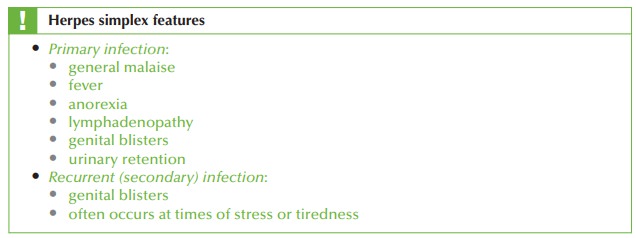Chapter: Case Study in Obstetrics and Gynaecology: Emergency Gynaecology
Case Study Reports: Urinary Retention
URINARY RETENTION
History
A
29-year-old woman presents to the emergency department having been
unable to pass urine for 8 h. For the last 3 days she has been feeling unwell
with a fever, shivering and a
reduced appetite. She has pain in her groins specifically but says that her whole body
aches. Yesterday she began to feel pain on passing
urine, and today
this has became
very severe such that
now she cannot
micturate at all.
She has never
experienced any episodes like this before. She
has no previous medical or gynaecology history and has
regular men- strual cycles.
She recently ended
a long-term relationship and has been with a new partner for a few months,
with whom she uses condoms.
Examination
The
woman is obviously in significant discomfort. Her temperature is 37.4°C, heart
rate 102/min and blood pressure 118/80
mmHg. Bilateral tender inguinal lymphadenopathy is noted and axillary lymph nodes are
also palpable. The
bladder is palpable midway to the umbilicus. The vulva is generally reddened
and there is a cluster
of ulcerated lesions
of approximately 2–5 mm on the left side of the labia minora.
Speculum examination shows the cervix is inflamed
with a profuse exudate.

Questions
·
What is the diagnosis?
·
How
would you further
investigate and manage this patient?
ANSWER
The
woman is demonstrating a classic presentation of primary herpes
simplex virus infec- tion. Prodromal ‘flu type symptoms
and generalized lymphadenopathy usually occur most significantly with primary infection, and any subsequent attacks are more likely to pre-
sent with vulval soreness as the only noticeable feature.

The
woman probably acquired the infection from
her new partner
– condoms do not effect- ively prevent spread as the organism
can spread from the perineum. In this case there is also
evidence of herpes
cervicitis from spread
of virus particles into the vagina.
Further investigation
Vulval viral swab should be sent to confirm
the diagnosis. This requires firm rubbing of the
swab onto an ulcer and is very painful, but as the diagnosis has such profound
social implications, confirmation of the diagnosis is imperative.
Management
·
Immediate management:
·
the woman should have an indwelling
(preferably suprapubic) urinary catheter inserted immediately and be given analgesia and paracetamol
·
local anaesthetic gel often
relieves the pain and can be used until symptoms
settle
·
oral aciclovir started within
24 h of an attack
reduces the severity
and duration of the
episode.
·
Further management:
·
referral to a health
counsellor should be made to discuss the diagnosis and its
implications
·
some women have many
recurrent attacks, whereas
others never experience a fur- ther episode. For recurrent attacks
aciclovir may be given again
if commenced within 24 h of becoming unwell.
Related Topics
